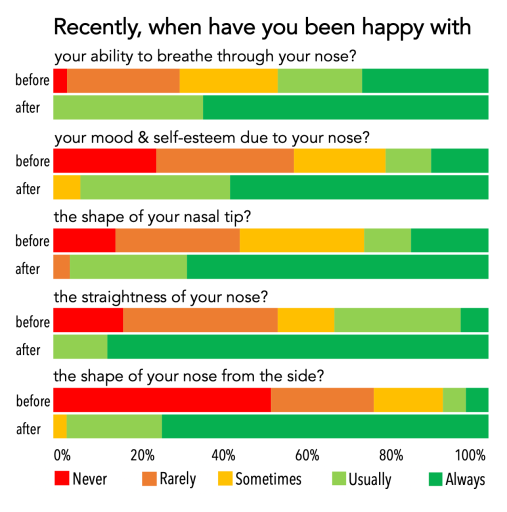Functional and Cosmetic Rhinoplasty & Augmentation
Rhinoplasty and facial implant surgery are often undertaken to correct the appearance of the nose, chin and cheeks. Rhinoplasty surgery encompasses a broad range of situations and techniques that aim to improve the nose both functionally and aesthetically. In all cases of nasal surgery it is important to ascertain both the functional and cosmetic issues that are present – many patients presenting for rhinoplasty have a degree of airway obstruction and this needs careful consideration as part of planning any operation. These are bespoke operations and I use digital photography planning tools to calculate the various dimensional changes required in any individual case.
- Septorhinoplasty and Breathe-Implant systems
- Preservation Rhinoplasty and Open Structural Rhinoplasty
- Piezo Ultrasonic Rhinosculpture
- Chin and Cheek Augmentation
- Rhinoplasty and Facial Augmentation case studies
- Patient Reported Outcome Measures relating to Rhinoplasty
Septorhinoplasty and Breathe-Implant systems
Functional nasal surgery is typically thought to be the domain of ENT surgeons. However, when septal problems (such as a crooked nose or nasal obstruction) are combined with a dislike of nasal appearance then septorhinoplasty surgery may be suitable.
Additionally, for patients whose breathing is a defining problem I am able to offer the “Breathe-Implant” system (Kurz instruments, Germany). This is specifically for patients who have weak nasal cartilage that collapses on inspiration; this is a useful addition to the range of techniques available for improving breathing in the setting of rhinoplasty surgery. These tiny implants have a very low profile and hold open the airways in a predictable fashion, giving relief from active nasal obstruction that is a problem for many patients. This addresses a significant functional problem within nasal surgery that I have a particular interest in having travelled widely to learn rhinoplasty techniques in UK, Europe, North America and Australasia, I combine numerous techniques and a wealth of world class experience to give durable results in this challenging area.
Preservation Rhinoplasty and Open Structural Rhinoplasty
Particular problems of septal deviation, alar retraction and tip droop (the polly beak nose) are minimised by use of septorhinoplasty techniques and cartilage grafts in various configurations. For primary cases (where surgery has not previously been undertaken) Preservation Rhinoplasty techniques may be used. Preservation Rhinoplasty includes a range of techniques that aim to preserve the beautiful normal structures of nose, whilst subtly altering the overall arrangement of these structures to reduce a dorsal hump, correct septal deviation and improve nasal tip definition.
Open Structural Rhinoplasty is typically indicated in revision cases and in more complex primary cases. In revision cases additional cartilage material from the septum or rib may be required to help construct the nose that is desired.
Piezo Ultrasonic Rhinosculpture
Within the array of instruments I have imported for this specialist work, I am able to perform Piezo Ultrasonic Rhinosculpture. This uses a specialist device to cut, smoothen and shape nasal bones without the unpredictability or trauma of traditional instruments. More complex configurations of bony work are possible using this leading to enhanced recovery and less bruising.
Chin and Cheek Augmentation
The use of chin implants and cheek implants may give additional balance to the face when needed. Many types of implant are available although silicone implants are most commonly used in my practice. These can be inserted through well-hidden incisions and can make powerful changes to improve facial harmony.
Read Mr Gore’s answers to frequently asked questions about rhinoplasty.
Rhinoplasty and Facial Augmentation Case Studies
- Anna – Septorhinoplasty
- Louise – Rhinoplasty and facial augmentation
- Alistair – Nasal reconstruction
Patient Reported Outcome Measures relating to Rhinoplasty





